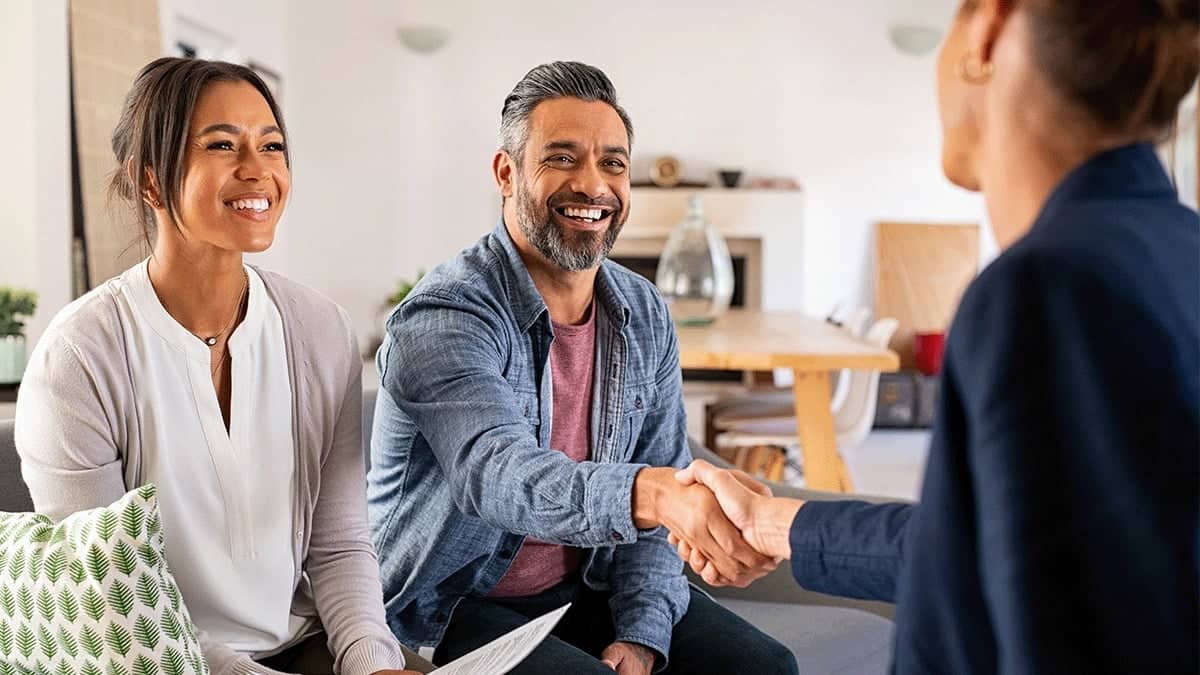Customer experience management (CEM or CXM) ensures you provide value at every touchpoint in the buyer’s journey. As a result, you’ll keep leads and customers in your pipeline instead of pushing them away to your competitors.
In this article, you’ll learn what customer experience (CX) is and why it matters. You’ll also discover customer experience solutions for building great in-store and digital experiences.
Key takeaways from customer experience
Customer experience refers to how people perceive your brand based on every interaction they have with you throughout the buying process.
Personalizing the experience, owning your mistakes and making support accessible turn one-time buyers into loyal customers.
Tracking metrics like customer satisfaction scores shows you exactly where to improve your CX strategy.
Pipedrive centralizes customer data so you can spot patterns and deliver better experiences – try it free for 14 days.
What is customer experience?
Customer experience, or CX, is a person’s perception and opinion of a brand, shaped by interactions with it throughout the buying process.
For example, if a buyer enjoys a product and consistently receives helpful support from the seller, their customer experience is generally positive.
Alternatively, if a company charges the customer twice for a purchase, the shopper doesn’t receive an order confirmation email or they can’t access support, their customer experience will likely be negative.
Interactions that contribute to the overall customer experience include:
Website visits
Order processes
Delivery services
Product intuitiveness
Onboarding
After-sales correspondence
All these touchpoints form the customer journey, a process involving five stages:
Stage | Details |
1. Awareness | What it is: Your prospects first learn about your products or services. Customer mindset: “I have a problem that needs solving.” Action: Create educational content that builds customer engagement. |
2. Consideration | What it is: Your prospects compare your solution to competitors. Customer mindset: “Which solution fits my needs best?” Action: Showcase your unique value proposition with sales demos and case studies. |
3. Decision | What it is: Your prospects commit to buying from you. Customer mindset: “Can I trust this company with my money?” Action: Remove friction with clear pricing and easy checkout. |
4. Retention | What it is: Your customers continue using and renewing your product. Customer mindset: “Am I getting my money’s worth?” Action: Deliver great customer support to build brand loyalty. |
5. Advocacy | What it is: Your customers recommend you to others. Customer mindset: “I love this product and want to share it.” Action: Make referrals easy with referral programs. |
At each stage of the buyer journey, customers will have different motivations, sales objections and emotions. By accounting for these specific customer needs, successful businesses create positive customer experiences.
Take Google’s after-sales service (the retention stage), for example. When a customer has a Google phone and they crack the screen, they’re stressed about finding a solution without added hassle.
A bad repair experience could send them to Samsung or Apple the next time they buy a new phone. However, Google minimizes this disruption by making it easy to book repairs.
The streamlined, self-service gives them two options. To walk into a store and get same-day repairs or mail their device and get it back in 7–10 days. This quick and frictionless process gives customers a positive experience, boosting their loyalty to Google.
Why you should optimize customer experience
Positive experiences promote customer loyalty and brand advocacy, ultimately making your business more profitable.
Bad customer experiences have the opposite effect, pushing customers away and into your competitors’ sales pipelines. Genesys found that 29% of customers would switch brands due to businesses failing to treat them with empathy during customer interactions.
You’ll reap plenty of benefits by consistently providing value at every touchpoint. Here are the most significant outcomes for a business routinely delivering great experiences.
Delivering great CX is a powerful differentiator
Regularly offering excellent service and convenience throughout the buyer journey will give you a powerful competitive advantage.
Researchers keep proving that these two critical aspects of CX influence buyers’ decisions. A 2023 survey of 1,000 US consumers found that almost half (48%) believe service is more important than price, while 88% consider convenience an essential factor.
Service and convenience should be part of the customer experience from your earliest interactions with your audience. That’s what will keep leads moving through the pipeline.
For example, make it easy for website visitors to get the information they need when researching your products. Add spec sheets to each product page or post expert-led demonstration videos on YouTube.
Employ product experts to answer questions through live chat, email and social media. These interactions will give prospective customers a taste of what it’s like to be your customer, even before they’ve spent any money.
Impressing leads and customers promotes brand loyalty
When you continue to deliver positive, memorable experiences after a lead converts, that person is more likely to become a loyal customer.
According to a Verint survey, 85% of respondents said they are likely to buy from a company again after receiving an amazing customer experience.
Using positive customer experiences to encourage repeat purchases can increase your customer retention rate (CRR) and reduce marketing costs.
Retaining customers is more cost-effective than finding new ones. Returning buyers already know your brand and require fewer sales and marketing resources to convert.
Data from Verint also shows that 87% consider responsiveness as the most important factor. Nearly three-quarters (74%) gave above-average ratings for effortless customer service.
Providing consistent value inspires brand advocacy
A customer who consistently has positive experiences with a brand is more likely to recommend it to others.
Word of mouth is a powerful, cost-effective way to generate leads and build trust. In the 2021 Nielsen Trust in Advertising Study, 88% of respondents said they trust recommendations from people they know more than any other channel.
Advocacy has many forms, and it pays to encourage them all. Running a referral program, where you reward existing customers for introducing new ones, is a practical and measurable tactic.
For example, Pipedrive’s referral program rewards users with account credit if they persuade three friends to sign up.
You can also politely ask your happiest customers to:
Write about your product on peer-to-peer review platforms (e.g., G2, Capterra, GetApp)
Provide testimonials
Complete customer feedback forms
Participate in case studies
Act as a client reference
Aim to build a library of social proof from happy customers in a range of industries. That should help you capture the attention and trust of a larger audience, increasing your sales opportunities.
6 ways to create loyalty-boosting customer experiences
An effective customer experience strategy comprises a set of actions designed to optimize value across all customer journey stages.
While every customer journey differs, prioritizing the following actions can cover most bases.
1. Personalize your sales and marketing interactions
Make every lead and customer feel important by personalizing your interactions with them.
Personalization across the entire customer journey, rather than only after an initial sale, will help you build trust and improve customer experiences.
According to Gartner’s Customer Service and Support Survey, 71% of business-to-consumer (B2C) and 86% of business-to-business (B2B) customers expect companies to be well-informed about their personal information during an interaction.
Customer-centric content marketing is a great place to start with email as your most direct channel.
For example, real estate platform Zillow sends personalized market updates based on locations users have saved. The email shows typical home values for the specific area, how prices changed from last year, the number of homes for sale and how many recently sold.
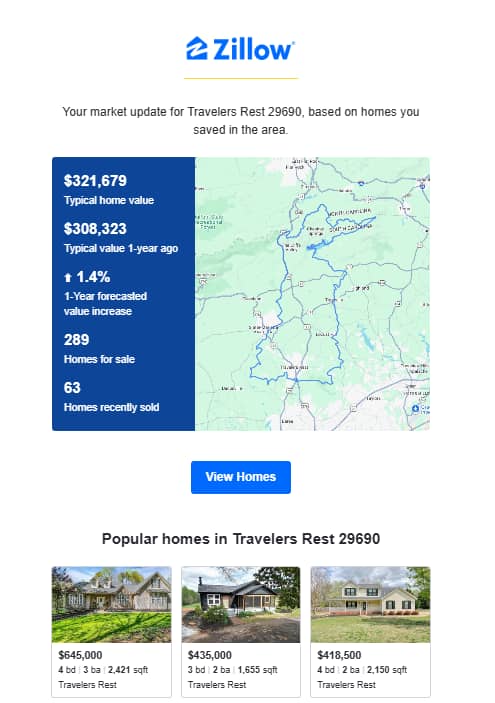
Zillow segments users by their saved searches and browsing behavior to share personalized information that helps prospects feel seen and valued.
You can use email marketing software to segment contacts into meaningful groups, enabling you to send relevant content to different sections of your audience.
Ensuring the right marketing content reaches the right people will also help you maintain a healthy email deliverability rate (the percentage of messages landing in recipients’ inboxes).
Recipients are less likely to report relevant, valuable content as spam. Meaning email service providers (ESPs) will have no reason to divert your future messages to their users’ junk folders.
2. Provide a thoughtful after-sales service
To scale your business, convert your customers into repeat buyers by consistently meeting their post-conversion needs.
One way to meet these needs is through quality customer service. In another study, PWC found 73% of consumers consider customer experience an important factor in their purchasing decisions.
Customers who feel appreciated are also more likely to recommend or endorse a brand, proving that after-sales services are worth your time.
You can also show new customers you care by:
Demonstrating appreciation. Use emails, phone calls and handwritten notes (where appropriate) to say “thank you” when buyers choose you over your competitors.
Providing pre-installation services. Anything that helps your customer install, configure or assemble their new product will help them squeeze more value from their purchase. Demo videos, technical specifications and product manuals are all helpful.
Offering user-friendly warranties, replacements and returns. Ideally, customers won’t experience issues with your product, but having solutions ready can reassure them they’ll be looked after if something goes wrong.
For your most loyal customers, go above and beyond by offering free bonuses and upgrades. Their continued business should cover any extra costs.
3. Keep all customer touchpoints consistent
Buyers will only get to know and trust your brand if their interactions are consistent.
Consider which of your company’s values and characteristics matter most to your target audience. Reflect those in all customer touchpoints to create a consistent, omnichannel experience.
For example, outdoor apparel brand Passenger makes sustainability central to its brand story. The company’s website features a dedicated sustainability page that highlights its tree-planting program.
The company has planted over 2.4 million trees worldwide and protected nearly 178 million square meters of rainforest. Nearly three-quarters (74%) of their products contain recycled or organic materials.

The company’s YouTube channel reinforces these values through content about nature, outdoor activities and plant-based cooking.
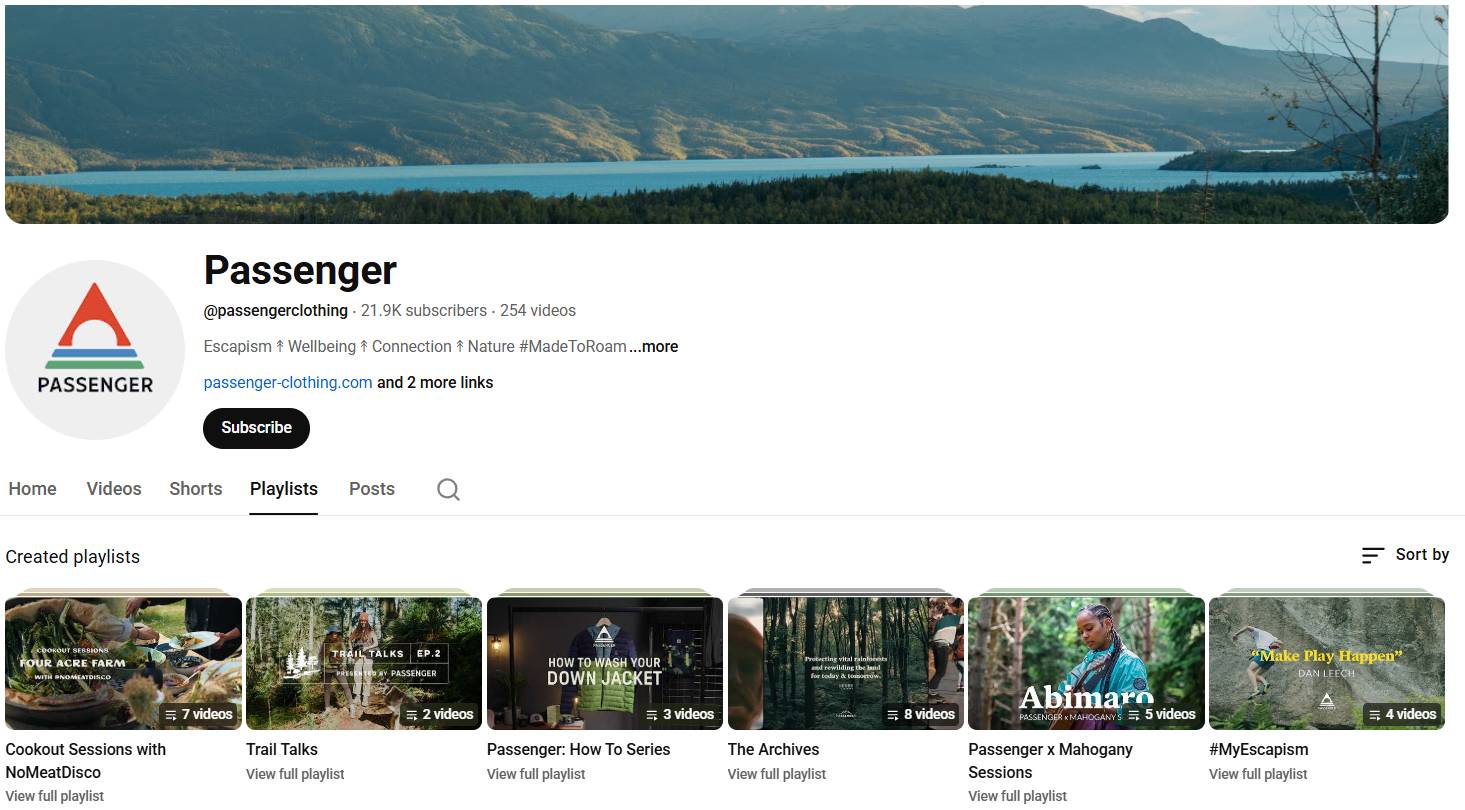
Prospective customers who visit Passenger’s website and YouTube channel get an accurate picture of what the company stands for. They can then gauge whether that brand image aligns with their values and confidently make a purchase decision.
Other interactions to keep tonally or visually consistent are:
Sales conversations
Chatbot messaging
Social media exchanges
Customer support team correspondence
Email marketing content
Mapping the customer journey can help you spot opportunities to make your brand story more consistent, as it’ll show you the most valuable touchpoints.
Download our customer journey map template
4. Revamp your onboarding process
Onboarding is a major opportunity to cement new customers’ trust, so treat this as the first impression of your product.
A smooth onboarding initiative contributes to a good customer experience in two ways:
It shows you care. Customers want to see you care about their problems more than just making a sale. Product demos, video tutorials and a willingness to answer questions show you want to help them.
It makes your product more valuable. Customers will get a better return on investment (ROI) when they understand how to use your product from the outset. It should also cut support queries, saving your customer service team time.
The onboarding process should be a personalized experience tailored to each customer’s needs. However, if you sell software-as-a-service (SaaS) products, you can use the following list of onboarding stages as a template:
Welcome email
Registration process
Product configuration
Feature callouts
Interactive walkthrough
Knowledge base
Routine follow-ups
Every time you go through these stages, note common questions and friction points. You can incorporate solutions to these issues into your process to provide a smoother, more valuable user experience.
For example, say you find mobile users typically make more support inquiries during the registration and product configuration stages. You might want to build a dedicated induction process for this audience, using mobile-first images and video demonstrations.
5. Make yourself available
Be available to answer customers’ questions, offer advice and provide personalized recommendations.
Being available will help you maintain buyers’ trust and enable them to get better results from their purchases, making them more likely to buy from you again.
Verint found that being able to contact a company in a preferred channel improves customer experience. Allowing customers to contact you through multiple channels will make the support process painless and more convenient.
For example, customers may prefer to resolve non-urgent issues (e.g., password resets or billing questions) via live chat or a chatbot. A contact center might be more suitable for addressing more pressing problems (e.g., system outages or payment failures).
Business insurance firm Superscript offers high-level support through an intuitive chatbot with a live chat feature built in.
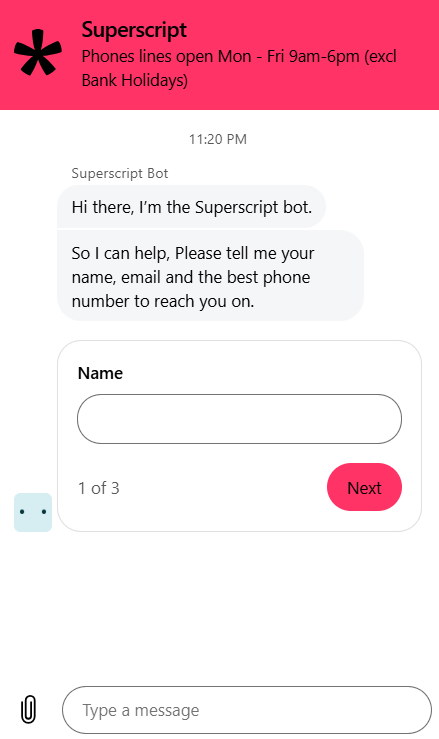
The company also provides email, phone, mailing details and real-time support for more specific or formal inquiries.

Verint’s survey also shows that quick response times have a significant impact on customer experience. If you’re using telephone calls to deliver support, ensure you have enough staff available.
You can reduce your support workload by offering helpful information in:
Online knowledge hubs
Video tutorials
Automation tips
Keep track of the topics customers inquire about most frequently so you can pre-empt their pain points. If people can get answers without contacting you, you’ll have more time to spend with customers who need your help with more complex inquiries.
6. Own your mistakes
Owning your mistakes quickly builds trust and turns service failures into loyalty wins.
Mistakes can lead to negative experiences, but they’re normal. You could send an email with a typo that causes an order delay or a misunderstanding that leaves a customer without valuable information.
Minimize the impact on customer experience by owning up and apologizing. Apologies can improve customers’ perception of your brand. You’re demonstrating your authenticity and showing that you’re willing to put things right.
After making a significant mistake, it’s crucial you:
Own up. Avoid getting defensive. Accept that the mistake was yours.
Explain what happened. Detail how the mistake came about so your audience sees that you’re being transparent.
Clarify how you’ll rectify the error. Explain how you’ll compensate the affected customer and how you’ll avoid repeating the mistake.
In the apology email below, sports equipment brand Luxiaojun assumes responsibility for a shipping delay caused by a USPS investigation.
The company takes full responsibility, offers a $25 gift card as compensation and addresses the customer’s chargeback request. Luxiaojun invites further contact if the customer needs more help.
6. Own your mistakes
Mistakes that negatively impact customers are normal. It could be an email sent in error, a typo that causes an order delay or a simple misunderstanding that leaves a customer without valuable information.
Minimize the impact on customer experience by owning up and apologizing. Apologies can improve customers’ perception of your brand by demonstrating your authenticity and showing that you’re willing to put things right.
After making a significant mistake, it’s crucial you:
Own up. Avoid getting defensive. Accept that the mistake was yours.
Explain what happened. Detail how the mistake came about so your audience sees that you’re being transparent.
Clarify how you’ll rectify the error. Explain how you’ll compensate the affected customer and how you’ll avoid repeating the mistake.
In the apology email below, e-commerce brand Framebridge explains what went wrong, apologizes for its mistake in a light-hearted way and invites recipients’ feedback.
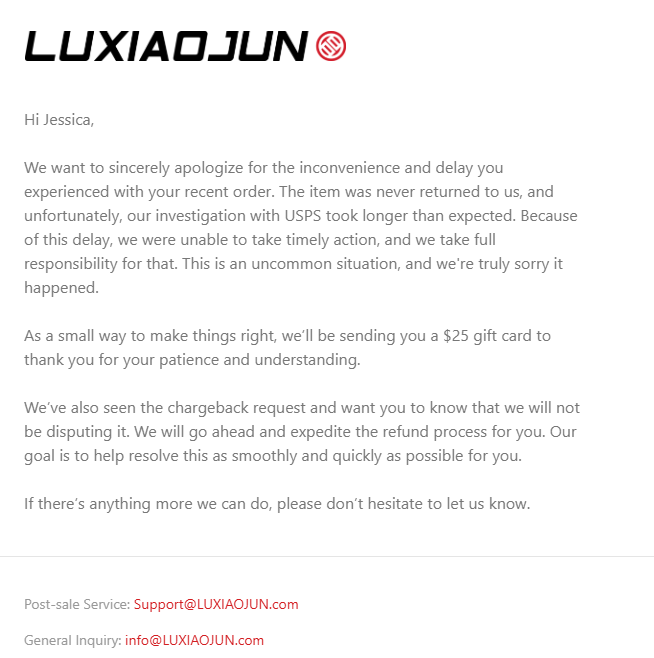
A Trust Signals study found that 48.17% of buyers are willing to give brands the benefit of the doubt after they make a mistake. In contrast, 14.5% of buyers wouldn’t (35% said “sometimes” and 2.33% answered “not sure”).
The biggest influence on people willing to see past companies’ mistakes is “trust based on personal experience”. So you can win favor with buyers by consistently being transparent and helpful.
How to measure and improve CX with Pipedrive
Measure your CX strategy to know where to focus your efforts and improve how leads and customers perceive your brand.
Here are four simple ways to collect valuable data to create better customer experiences with a customer relationship management (CRM) tool like Pipedrive.
1. Use customer satisfaction surveys
The results of customer satisfaction (CSAT) surveys offer insight into your customers’ experiences with your brand.
Aim to collect customer data after key moments in the buyer journey, such as transactions, registration, onboarding and support queries.
Pipedrive's marketplace provides a wide range of integrations, including web forms and surveys, allowing users to easily automate customer surveys. Results are collected and visible all in one place, making it easy and convenient to manage customer feedback.
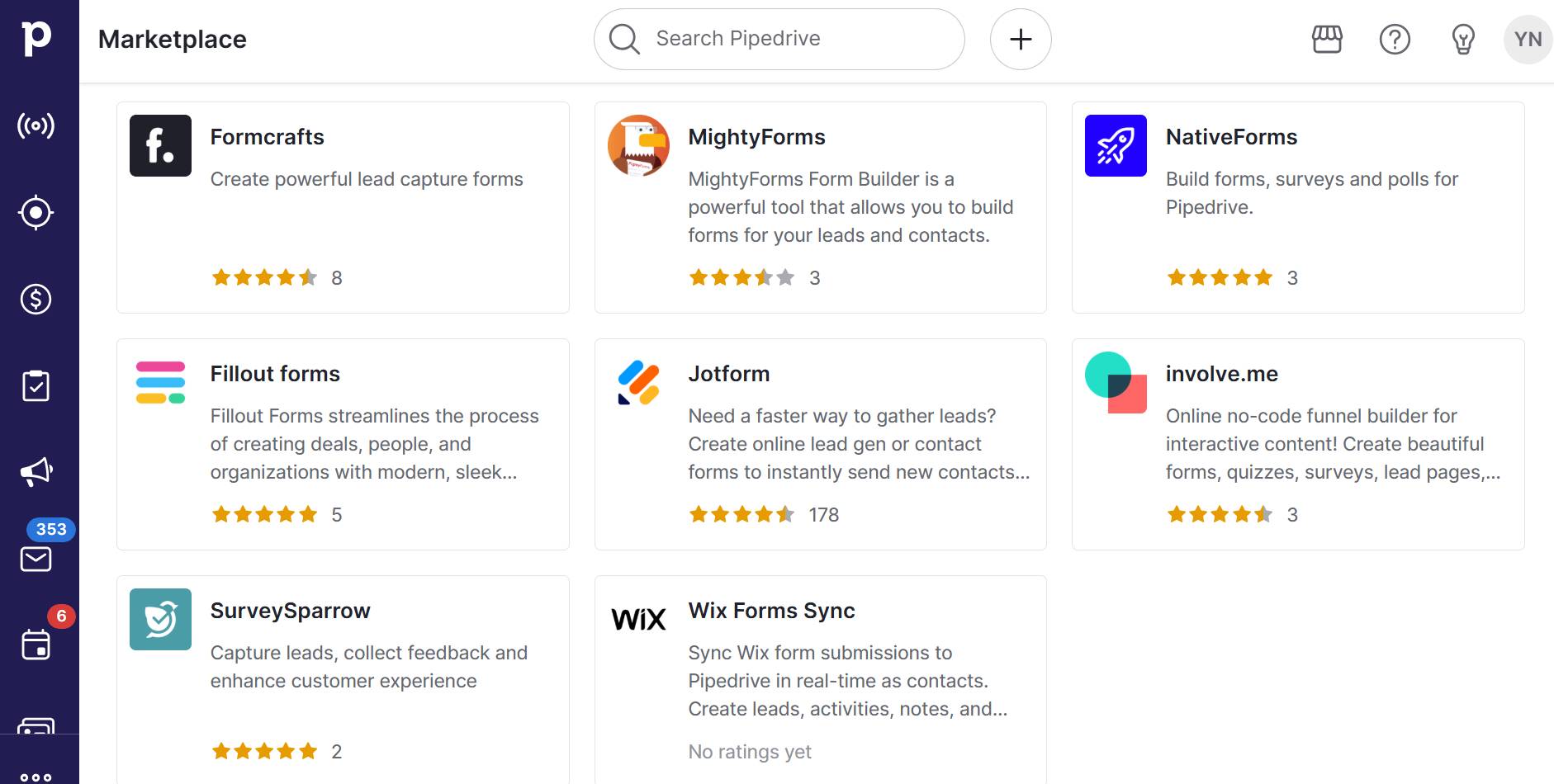
When assessing CX at the transaction stage, you might ask the following questions in your customer survey:
“How easy did you find paying for our product?”
“Were our payment options adequate?”
“Is there anything that would have made your purchase experience more enjoyable?”
If you were measuring satisfaction around a support query, you could ask:
“Did we solve your problem?”
“Did our support staff communicate clearly, using language you understood?”
“Are there any communication channels you’d like to have available for support?”
Web forms capture survey responses in Pipedrive so you have all the data in one place. You’ll see who responded, what they said and when they submitted feedback.
Look for patterns. Your happiest customers might share common traits, such as industry or deal size.
You can gain more insights using customer experience metrics or KPIs, such as Net Promoter Scores (NPS) or Customer Effort Score (CES). Ask a question like: “On a scale of 0 to 10, how likely are you to recommend our product/company to a friend or colleague?”
2. Track website analytics data
Your website is a key part of the customer experience, so you should measure how it performs.
Website analytics data, which you’ll find in a tool like Google Analytics, will tell you:
How long people stay on your website
How many pages people visit
How long people stay on individual pages
Which pages are the most popular
Which links visitors click on most often
How people find your website
That information will help you identify strengths and weaknesses in your digital CX.
For example, say your top-performing page is a “how-to” guide about one of your products. You’ll know that type of content contributes positively to the buyer journey.
Pipedrive takes this a step further by allowing you to integrate the Google Analytics Connector into Pipedrive’s CRM to track which website visitors turn into actual deals in your pipeline.
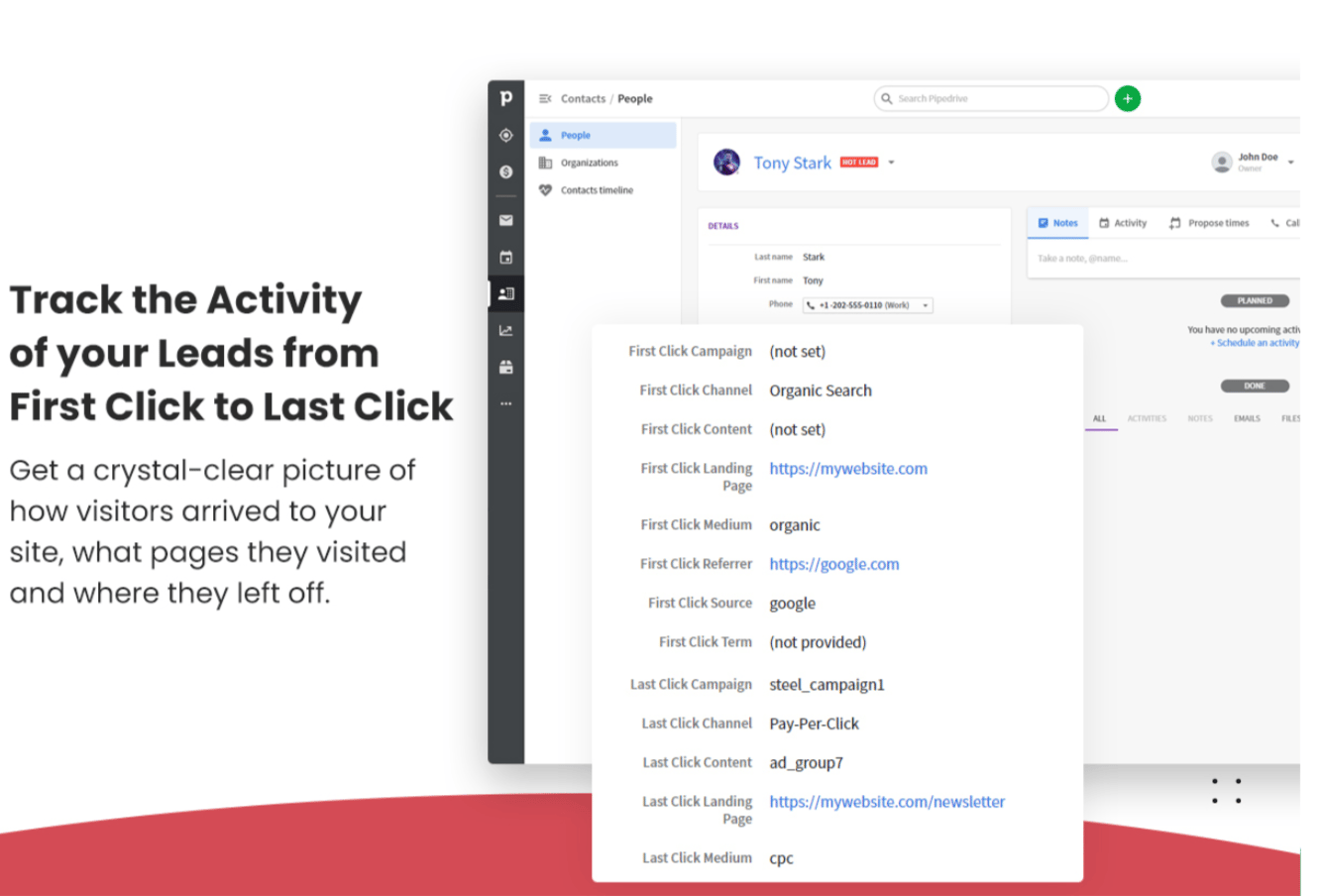
You simply need to drop a tracking script on your website and then enable the connector in Pipedrive. From there, every lead and deal shows exactly where it came from, whether that’s a blog post, paid ad or email campaign.
You’ll see which marketing efforts generate revenue, not just traffic. Moreover, your sales team gets context on every lead’s journey.
Pipedrive in action: Framery, a Finnish company that builds soundproof meeting spaces, tracked leads in spreadsheets and emails. Different versions piled up on shared drives. The team didn’t have visibility into which companies visited their website.
With Pipedrive’s Leadfeeder integration, website visitor data now flows automatically into their CRM. The sales team can see which companies browse their site and follow up accordingly. These features helped Framery increase lead generation by 800% and revenue by $1.5 million.
3. Monitor the reasons behind customer churn
Track why customers leave so you can identify and address what isn’t working and ultimately increase your bottom line.
Speak frankly with customers who end their relationships with your business. Ask why they’ve decided not to buy again or renew their contracts. Find out what they appreciated and didn’t like about your products and services.
Collect responses using a standardized survey you issue whenever a contract ends. You can also ask informally when the customer gives notice.
To analyze churn, check for patterns in Pipedrive. Filter your deals in the pipeline view by deals lost or any specific filter you want to include.
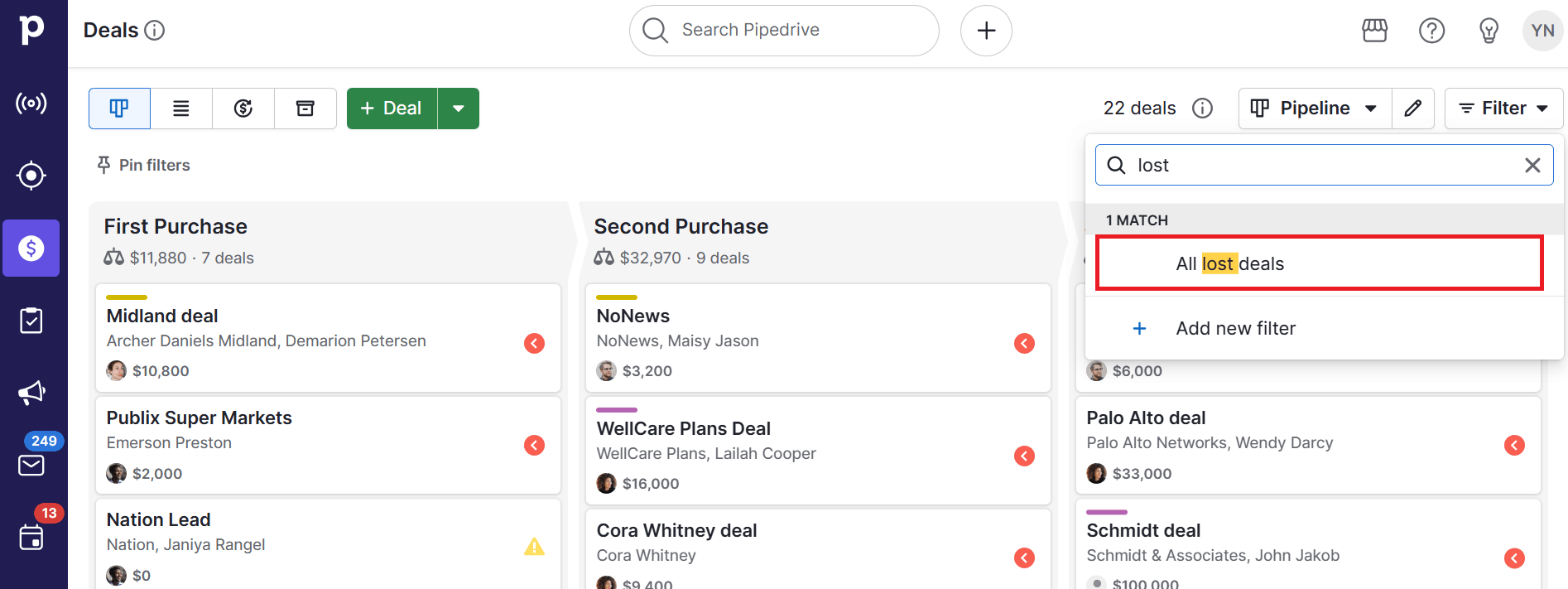
Review the notes your team logged during each sales conversation and look for complaints. Maybe prospects mention that pricing is too high or that a competitor offers faster implementation.
Alternatively, you can go to Insights and check which pipeline stage loses the most deals. Click on “+ > Report > Deal > Conversion”.
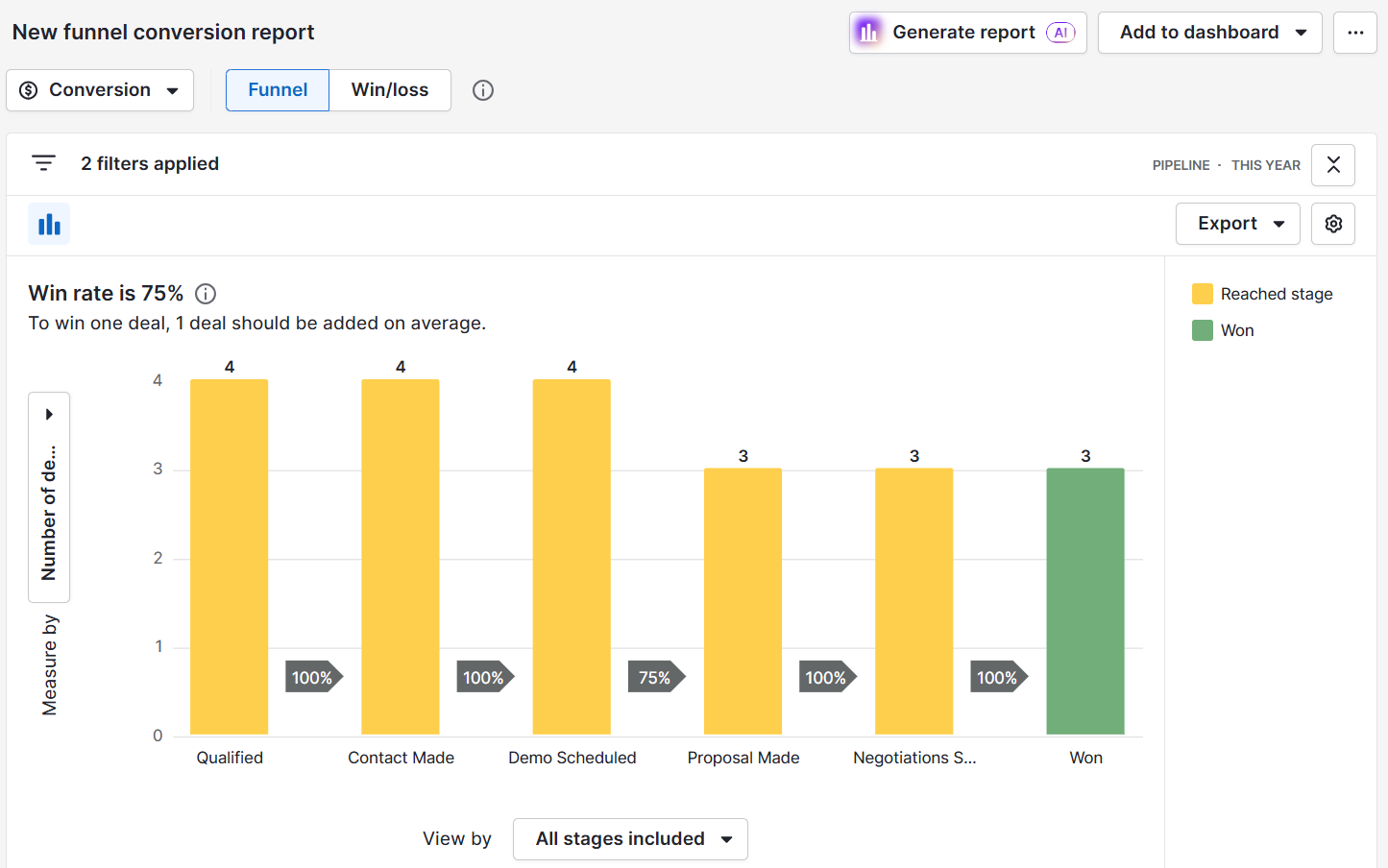
If prospects consistently drop off after the demo, your product presentation needs work. If they bail during contract review, your terms might be scaring them away.
Whichever method for gathering data you choose, you’ll gain valuable insights that will help you eliminate friction from future relationships and hopefully increase recurring revenue.
Pipedrive in action: CreativeRace, a marketing agency, lacked a defined sales process. Leads were getting lost in the pipeline. The agency used Pipedrive’s customizable pipelines to separate lead generation from sales.
The reporting functions helped them track team performance better. Now, CreativeRace uses Insights to forecast revenue and track lead lifecycle velocity. Client acquisition increased 600% year-over-year.
4. Map your sales pipeline to find and eliminate friction
Customize your sales pipeline to pinpoint exactly where deals die, so you can address those bottlenecks quickly..
Start by opening the pipeline view to create custom stages that match your actual sales process.
Name your stages things like “qualified”, “contact made” or “demo scheduled” so your team knows exactly what each one means. Add as many stages as needed to represent your entire sales cycle.
Drag deals between stages as they progress. Check your pipeline weekly to identify where deals are piling up or stalling.
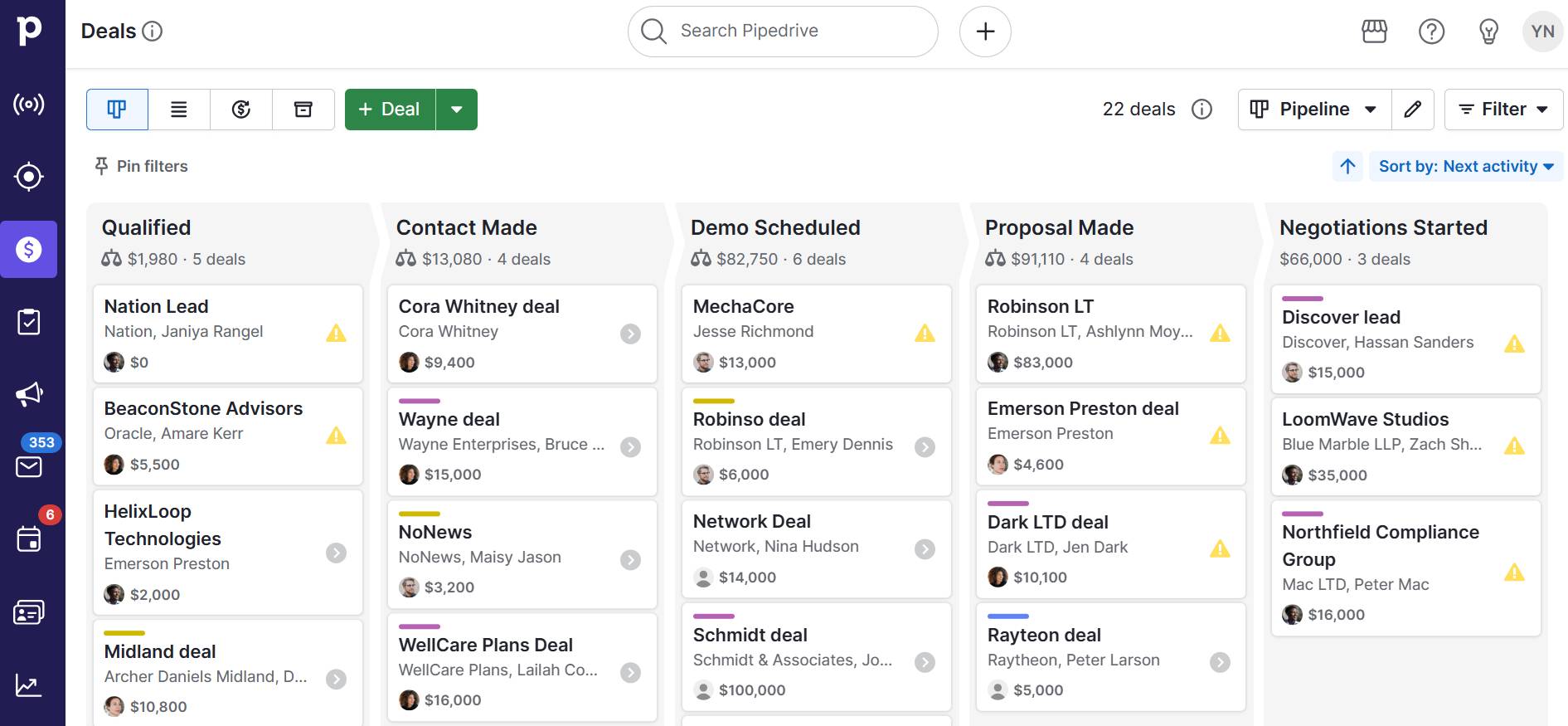
For example, if you generate plenty of high-value leads but most go cold after the first meeting, you might find:
You’re sending the wrong sales representatives to meetings
Your reps don’t have the sales materials they need, affecting employee experience
Your team needs more product training
Pipedrive’s intuitive visual interface makes sales pipeline management easy. Create multiple pipelines for different products or sales motions. You can track enterprise deals separately from SMB deals, so each gets the attention it deserves.
If you’re not ready to invest in a CRM or customer experience software, you can use a spreadsheet tool to create your sales pipeline template.
Pipedrive in action: Document360, a SaaS company, upgraded from using spreadsheets to track deals to creating customized pipeline stages in Pipedrive’s dedicated CRM solution.
The visual interface helps the company identify its best customer profiles based on successful deal characteristics and also saves the sales team four to six hours per week on admin work.
Final thoughts
Creating a great customer experience is the best way to generate high-value leads. You can build solid relationships and entice repeat business.
Keep in mind that your customer expectations evolve over time. What impresses now may not work forever. Revisit your CX strategy regularly to account for changes to your buyer personas, buying patterns and competitors’ offerings.
Pipedrive tracks every customer interaction from first contact to final sale. Start a 14-day free trial and build better customer experiences with less effort.








